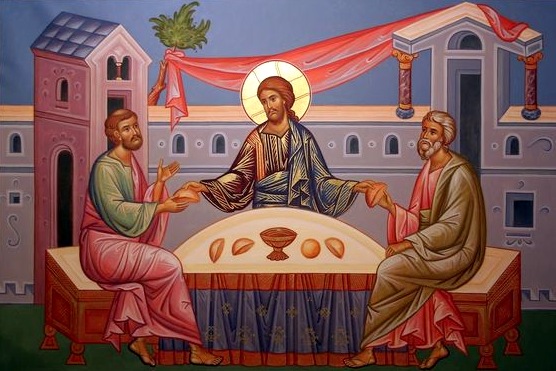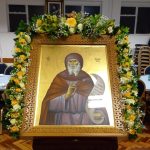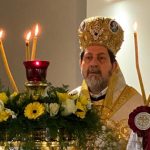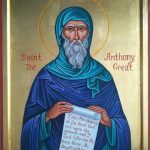The Eucharistic Prayer
Part 2
After the opening blessing the celebrant invites us to join with him in the great Prayer of Thanksgiving in a dialogue that goes back to the earliest days of the Church, and is still found in the liturgies of both East and West. In the Cherubic Hymn we sang, ‘Let us now lay aside every care of this life’, now we are told to ‘have our hearts on high’, that is, where Christ is seated at the right hand of the Father. St Cyril of Jerusalem, talking to the newly baptised, says, ‘After this the priest cries, “On high the hearts”. Truly at that most fearsome moment one must have the heart with the Lord, and not below close to earth and earthly affairs’. St Nicolas Cavasilas makes the same point in his commentary on the liturgy, ‘Having given them this blessing and thus raised their souls from the earth, the priest lifts up their thoughts and says, “Let our hearts be on high”, “Let us think on the things on high, not those on earth”. And they give their assent and say that they have their hearts “there where our treasure is”, where Christ is enthroned at the right hand of the Father, “We have them with the Lord”’. In the West St Augustine is equally clear, ‘After the greeting that you know, that is, “The Lord be with you”, you hear, “Heart on high”. The whole life of true Christians is “heart on high”, not that of Christians in name only, but of Christians in reality and truth. Their whole life is “heart on high”. What then is “heart on high”? It is hope in God, not in yourself, for you are below, God is on high. If your hope is in yourself, your heart is below, it is not on high. And so, when you have heard from the priest, “Heart on high”, you answer, “We have [it] with the Lord”. Make sure that you make a true answer.’
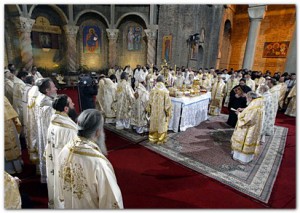
Then the priest asks us to give thanks, ‘Let us give thanks – Εὐχαριστήσωμεν – to the Lord’. Here we reach the heart of the Liturgy. The word ‘Thanksgiving’, ‘Eucharist’, has become one of the names that we use for the whole Liturgy. If we have been saved, if God himself has become one of us, has died for us and raised us with himself from the power of sin and death, then our first duty is to be grateful, to thank him for all that he has done for us, for all that we have and are. And so we reply, ‘It is right and fitting’.
The priest now begins the great prayer of Thanksgiving, the great prayer of Offering, in Greek Anaphora, by taking up our reply and developing it by reminding us of some of the many things for which we should give praise and thanks to God. We thank God for creating us and raising us up again when we had fallen and making us heirs of the Kingdom of heaven. The first part of the prayer reaches its climax with us joining in the hymn of victory and thanksgiving that the choirs of heaven sing unceasingly before the throne of God. ‘Holy, holy, holy, Lord of hosts; heaven and earth are full of your glory. Hosanna in the highest. Blessed is he who comes in the name of the Lord. Hosanna in the highest!’
The first part of this hymn is taken from the Prophet Isaias. One day, when he entered the Temple in Jerusalem, he was granted a vision of God. He describes his vision like this: ‘In the year in which king Ozias died, I saw the Lord sitting on a high and exalted throne, and the house was full of his glory. And Seraphim stood round about him. Each one had six wings: and with two they covered their face, and with two they covered their feet, and with two they flew. And they were crying to one another, and saying, “Holy, holy, holy, is the Lord God of hosts, the whole earth is full of his glory”.’ At the sight of the glory and holiness of God Isaias is overcome with his awareness of his own unworthiness and uncleanness. As we join in the angels’ sing, we should be aware of our unworthiness, but also of what a privilege it is to be allowed to join the chorus of praise. Later in on in the course of the Liturgy we shall meet Isaias and his vision again.
The second part of the hymn is taken from the Gospel of St Matthew, where the crowds on Palm Sunday welcome Jesus, as he rides into Jerusalem, with words from Psalm 117. We too are about to receive Christ, not simply into the holy city, but into ourselves in holy Communion. The crowds in the Gospel were fickle, and by Friday had turned against Jesus and were shouting for his death. It is worth remembering this as we sing our song of welcome. The Gospel, and the Liturgy keeps the Hebrew word ‘Hosanna!’, which we usually feel to be a shout of joy, but in the Psalms we find the meaning, ‘Save us now!
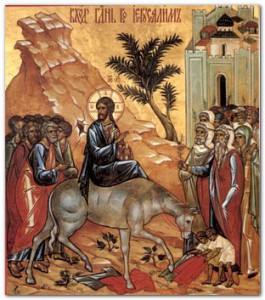
In the early days of the Church, of course, the people would have been able to hear whole prayer, as it was said out loud, but over time it came to be said so quietly, mystikos in Greek, that it was in effect silent. This meant that the singers used ever more elaborate melodies to ‘cover’ what the priest was saying silently. They even added words to the people’s reply ‘It is right and fitting’. This addition is still used in some churches, in particular in Russia and on the Holy Mountain. Where the prayer is said aloud both this reply and the ‘Holy, holy, holy’ should be sung to short and simple melodies in which the people can join. The prayer is a dialogue between the celebrant and the people, not a duet between priest and singers.

